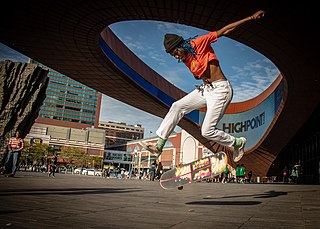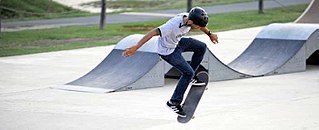Related Research Articles

Skateboarding is an action sport that involves riding and performing tricks using a skateboard, as well as a recreational activity, an art form, an entertainment industry job, and a method of transportation. Skateboarding has been shaped and influenced by many skateboarders throughout the years. A 2009 report found that the skateboarding market is worth an estimated $4.8 billion in annual revenue, with 11.08 million active skateboarders in the world. In 2016, it was announced that skateboarding will be represented at the 2020 Summer Olympics in Tokyo, for both male and female teams.

A skateboarding trick, or simply a trick, is a maneuver performed on a skateboard while skateboarding. Skateboarding tricks may vary greatly in difficulty.
Grind is the cross-sectional shape of a blade.

A half-pipe is a structure used in gravity extreme sports such as snowboarding, skateboarding, skiing, freestyle BMX, skating and scooter riding.

Longboarding is riding on a longboard. Longboards vary in shape and size. Compared to skateboards, longboards are more stable, and have more traction and durability due to larger wheel size and lower wheel durometers. Generally, a skateboard comes in between 28-34 inches long and 7-10 inches wide, while a longboard has a length of 35-60 inches and a width of 9-10 inches. Many longboards use trucks (axles) that have different geometric parameters than skateboards. There are a variety of longboard disciplines, and types of longboards. Longboarding has competitive races down hill where riders can reach speeds exceeding 60 mph (97 km/h). The wider turning radius of longboards, as well as their ability to coast long distances make them more suitable for cruising and commuting on streets than regular skateboards.
Footedness is the natural preference of one's left or right foot for various purposes. It is the foot equivalent of handedness. While purposes vary, such as applying the greatest force in a certain foot to complete the action of kick as opposed to stomping, footedness is most commonly associated with the preference of a particular foot in the leading position while engaging in foot- or kicking-related sports, such as association football and kickboxing.
Frontside and backside are surfing, skateboarding, snowboarding and aggressive inline skating terms that are used to describe how a person approaches an obstacle or performs a certain trick. In Aggressive Skating, frontside and backside are types of grinds.
A freestyle skateboarding trick is a trick performed with a skateboard while freestyle skateboarding. Some of these tricks are done in a stationary position, unlike many other skateboarding tricks. The keys to a good freestyle contest run are variety, difficulty, fluidity, and creativity. This is an incomplete list, which includes most notable tricks.

In skateboarding, grinds are tricks that involve the skateboarder sliding along a surface, making contact with the trucks of the skateboard. Grinds can be performed on any object narrow enough to fit between wheels and are performed on curbs, rails, the coping of a skate ramp, funboxes, ledges, and a variety of other surfaces.

A slide is a skateboarding trick where the skateboarder slides sideways either on the deck or on the wheels.
Transworld Skateboarding (TWS) was an international magazine on skateboarding that was based in Carlsbad, California, United States. The publication also ran an accompanying website and video production company. In February 2019, the publishers of Transworld magazine, The Enthusiast Network, were purchased by American Media, Inc. In March 2019, the print edition of Transworld magazine was discontinued.

A grind rail is an object used by skateboarders to do skateboarding tricks on such as grinds and slides. It is usually square or round.
The Rincon Big Four is a famous skate spot in Escondido, California, USA that has shown up numerous times in skateboard media outlets, such as videos and magazines. It is located at Rincon Middle School, which has been a popular landmark for skateboarding for over a decade. In 1997, Jamie Thomas found a newly built bleacher set for shaded basketball.

A skateboard is a type of sports equipment used for skateboarding. They are usually made of a specially designed 7-ply maple plywood deck with a polyurethane coating for smoothness and durability and wheels attached to the underside by a pair of skateboarding trucks.
A pole jam is a skateboarding trick maneuver that skateboarders do over a bent pole. A pole jam is an action that skateboarders do when they approach a bent pole and they then continue to ride up and over the top of the pole.

Aggressive inline skating is a sub discipline of inline skating in the action sports canon, which emphasizes the execution of tricks. Aggressive inline skates are specially modified to accommodate grinds and jumps. Aggressive skating can take place on found street obstacles or at skate parks.

Street skateboarding is a skateboarding discipline which focuses on flatground tricks, grinds, slides and aerials within urban environments and public spaces. Street skateboarders meet, skate and hang out, in and around urban areas referred to as "spots", which are commonly streets, plazas or industrial areas. To add variety and complexity to street skateboarding; obstacles such as handrails, stairs, walls, flower beds, bins, park benches, picnic tables and other street furniture may be traversed as part of a single trick or a series of consecutive tricks called a line.

Skatestopper is a skate-deterrent device placed on urban terrain features such as benches and handrails to discourage skateboarding on the surfaces where they have been installed. The name Skatestopper is a registered trademark of Intellicept of El Cajon, California, but in some skateboarding circles it has become a genericized term referring to any anti-skate device.
Anti-skate devices or skate deterrents are fixed protrusions on structures which prevent skateboarders from grinding on them and are a form of hostile architecture. The most basic design is an L-shaped bracket affixed at intervals along the grind-able structure. Early designs were made from nylon while more recent designs have been made from aluminum. At the same time more ornamental versions have been produced. The devices have been targeted for removal by skateboarders resulting in attempts to make them tamper resistant.
References
- ↑ Wixon, Ben (2009). Skateboarding: Instruction, Programming, and Park Design. Human Kinetics. p. 85. ISBN 978-0-7360-7426-1.
- ↑ Weil, Ann (2005). Aggressive In-Line Skating. Capstone. p. 14. ISBN 978-0-7368-2708-9.
| | This sports-related article is a stub. You can help Wikipedia by expanding it. |